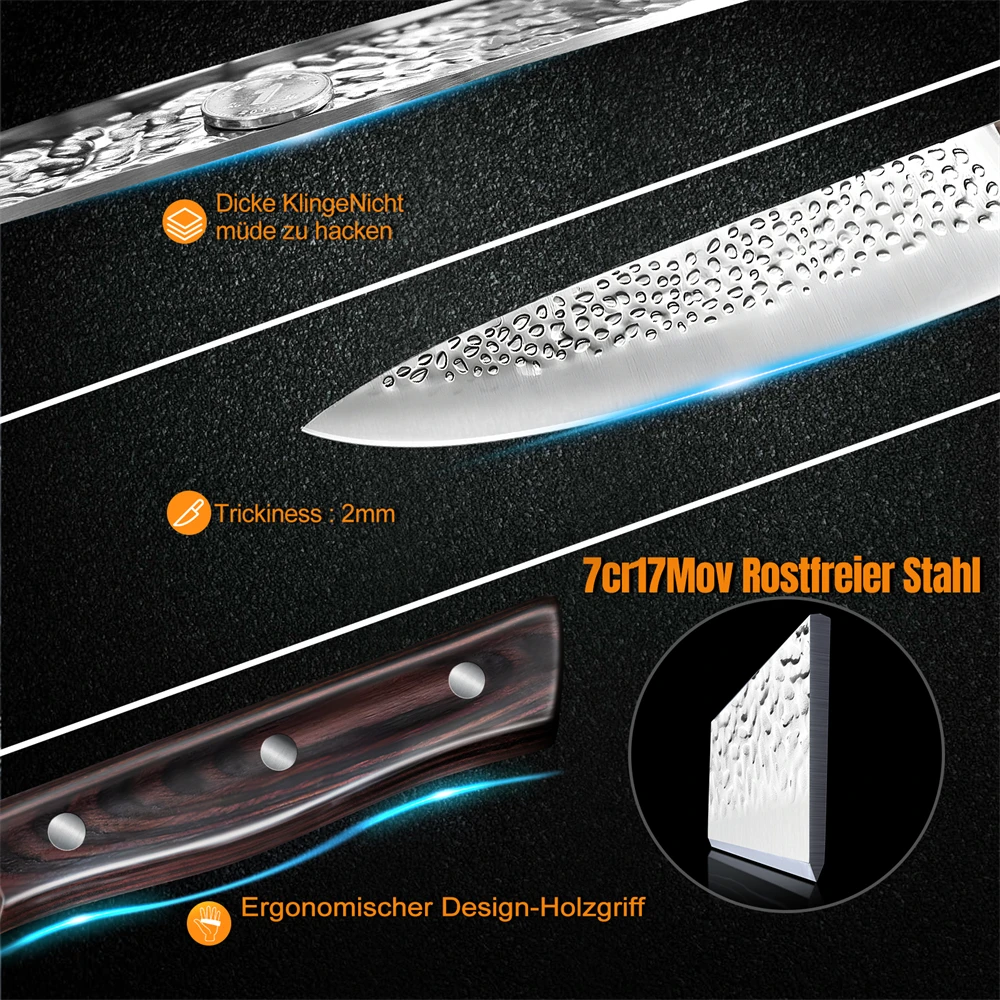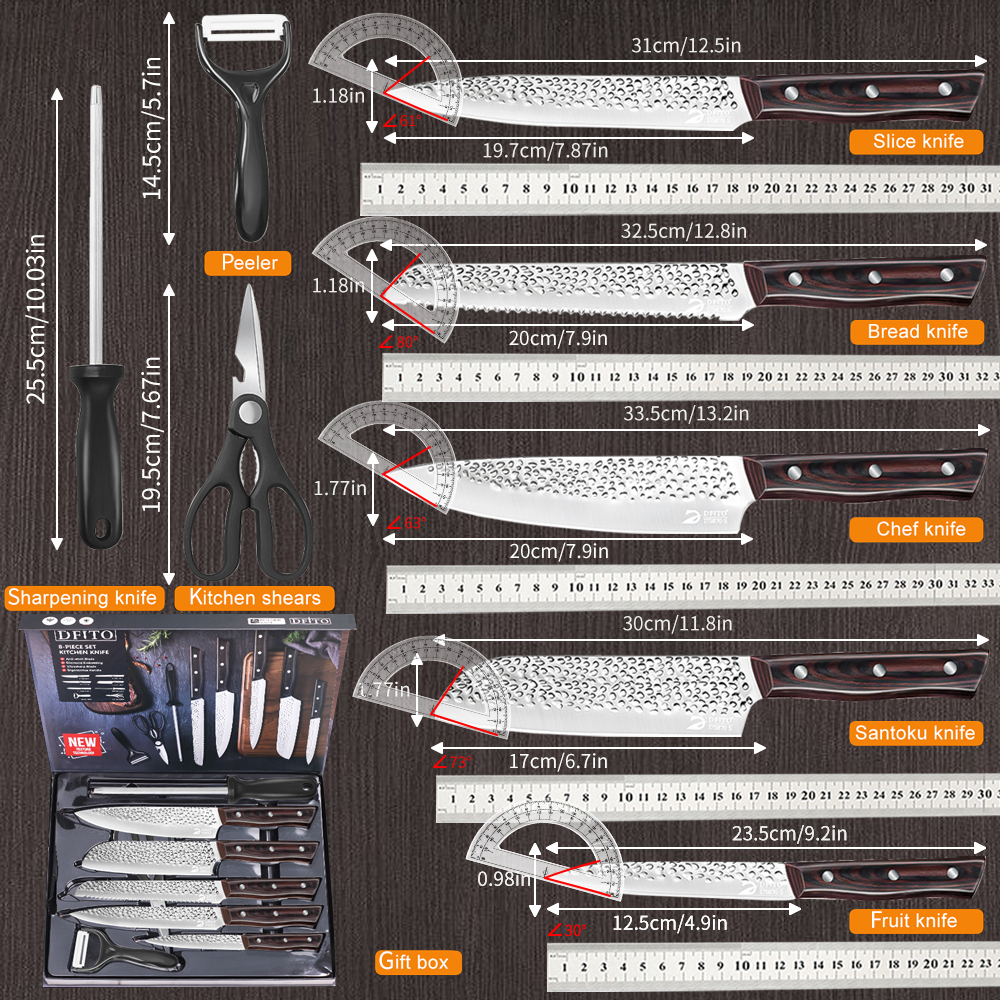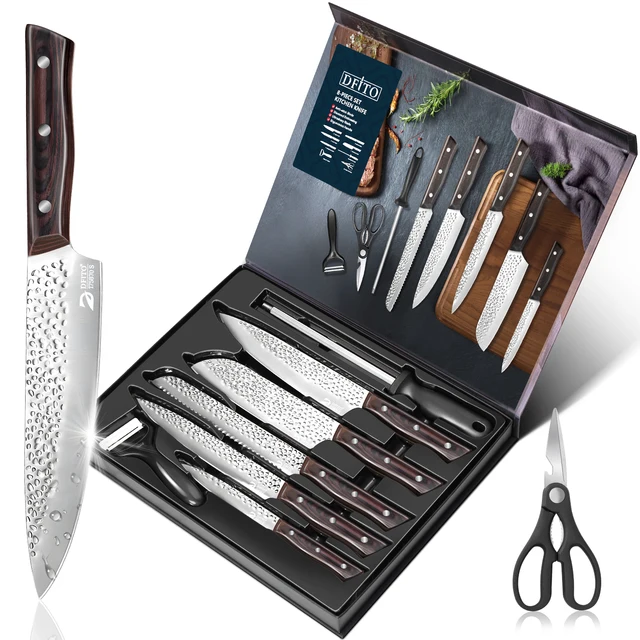Signs It’s Time to Replace Your Knives
Noticeable Chips in Blades
Over time, using your kitchen knives can lead to wear and tear. One clear sign that it’s time to consider that how to dispose of kitchen knives. These chips can affect the cutting performance and may even pose a safety risk if they cause the knife to slip during use.

Bends or Breaks at the Tip
The tip of a knife is crucial for precise cuts. If you find the tip of your knife is bent or has broken off, it’s a signal that the knife has endured too much and needs to be replaced. A damaged tip compromises the functionality and effectiveness of the knife.
Loose or Detachable Handles
Handles that are loose or detach from the blade can create unsafe conditions in the kitchen. When the handle is not secure, controlling the knife becomes difficult and risky. This instability can lead to accidents, making it essential to replace knives with faulty handles.
Loose Rivets on Knife
Rivets hold the handle to the blade of the knife. If these rivets are loose, the knife’s structural integrity is compromised. This not only makes the knife difficult to use but also increases the risk of breakage. A knife with loose rivets definitely needs inspection and likely replacement.
Different Methods for Disposing of Knives
When the time comes to part with old kitchen knives, there are several safe and responsible options. Here’s a look at different methods to consider when determining how to dispose of kitchen knives.
Selling Your Used Knives
If your knives are still in good condition, selling them might be a smart choice. Platforms like online marketplaces can connect you with people looking to buy used knives for a lower cost. Take clear photos, write honest descriptions, and set a fair price to attract buyers. Remember to handle transactions safely.
Donating Your Old Knives
Donation is another excellent way to give your old knives a second life. If they’re still usable, consider offering them to charitable organizations, soup kitchens, or friends. Check with local charity shops or culinary schools that might need kitchen utensils. Your old knives could help someone in need.
Recycling Your Unwanted Knives
When knives are too worn to be reused, recycling them is an eco-friendly alternative. Don’t throw them in the bin with other recyclables. Instead, find a local scrap metal facility. They can melt down and repurpose the metal. This helps reduce waste and can be a responsible choice.
Safe Ways to Throw Away Knives
Sometimes disposal is the only option. If you must throw your knives away, do so safely. Wrap the blades in thick newspaper or use bubble wrap to prevent injuries. Secure the wrap with tape and leave the handles exposed for clear visibility. Always inform your waste management service that you are tossing sharp objects. This careful approach protects you and waste workers from harm.
Selling Your Knives: Tips and Platforms
When you decide to dispose of kitchen knives by selling them, ensure they are in good condition. Start by cleaning your knives thoroughly. Sharp, well-maintained knives can attract higher prices.
Tips for Selling Knives:
- Use Quality Photos: Capture clear, high-resolution images of your knives. Show any unique features or brand marks.
- Write Honest Descriptions: Detail the condition of each knife. Mention any wear and tear or unique qualities.
- Set Fair Prices: Research what similar knives cost new and used. Price yours competitively to attract buyers.
- Choose the Right Platform: Popular online marketplaces like eBay or Craigslist are good options. These platforms have a large audience of potential buyers looking for kitchen tools.
- Ensure Safe Transactions: If meeting a buyer in person, choose a public place. For shipping, package the knives securely to prevent damage during transit.
Selling your knives can give them a new life in another kitchen. It’s a smart way to recoup some value from your old tools. By following these tips, you can make the selling process smooth and safe.
Donating Knives: Where to Donate and What to Consider
When you choose to dispose of kitchen knives through donation, several options and considerations come into play. Here are practical pointers to ensure your knives serve a good cause efficiently.

Where to Donate Your Knives:
- Charitable Organizations: Many nonprofits and charity groups welcome kitchen tools. These include soup kitchens and shelters.
- Culinary Schools: Budding chefs can benefit from your old knives. Reach out to local schools.
- Friends and Family: Know someone setting up a new home? Your knives might be helpful.
- Community Centers: These local hubs often conduct cooking classes where your knives can be of use.
What to Consider Before Donating Knives:
- Condition of the Knives: Make sure the knives are still functional. They should be clean and reasonably sharp.
- Safety: Wrap the knives securely. Ensure the blade is covered to prevent accidents.
- Legal Considerations: Check local laws about donating knives. Some areas have restrictions.
- Transportation: If delivering knives yourself, ensure they are securely packed and handled with care.
Donating knives can provide significant help and make a positive environmental impact. Always ensure the recipient can use the knives safely and legally.
Recycling Knives: How and Where to Recycle Properly
Recycling old kitchen knives is a responsible choice when they’re too damaged to use or donate. Here’s how you can do it properly:
- Prepare Your Knives: Clean your knives first. Remove any non-metal parts, if possible. This helps the recycling center.
- Find a Scrap Metal Facility: Search for a local scrap metal recycling center. They accept steel and other metals.
- Package Knives Safely: Wrap the blades in cardboard or thick material. Secure the package with tape.
- Drop Them Off: Take your packaged knives to the recycling center. Some places may offer pick-up services.
- Ask About the Process: Learn how the center recycles the metal. It’s good to know how your items are repurposed.
Remember, throwing knives in the bin with other household items is not safe. Always choose a recycling option that handles metals specifically. This way, you dispose of kitchen knives in a way that’s safe for everyone and good for the environment. Plus, you’ll be contributing to the circular economy by allowing the metal to be used again. It’s a smart move for those looking to clear out old knives without adding more waste to landfills.
Throwing Away Knives: Steps to Prevent Injury
When no other option is left, throwing knives away must be done with care. Here are steps to prevent injury when discarding knives.
Wrap the Blade Properly: Use thick newspaper, cardboard, or bubble wrap to cover the blade. This prevents cuts.
Secure the Wrap: Tape the wrapped blade to stop it from becoming exposed. Use strong tape.
Leave the Handle Visible: Keeping the handle out helps garbage collectors see it’s a knife. This avoids accidents.
Inform Waste Management: Tell your trash service there are sharp items. This ensures their safety.
Disclaimer Note: Attach a warning note stating a sharp object is inside. It’s a responsible step.
Keep it Away from Other Trash: Place the wrapped knife outside the trash bag. This avoids injury to anyone.
By following these steps, you dispose of kitchen knives safely, protecting yourself and others from potential harm.
Choosing the Right Disposal Method
Once you’ve determined that it’s time to say goodbye to your old kitchen knives, the next step is identifying the best disposal method tailored to their condition and your preferences. Each option has its advantages and proper procedures, so let’s review them to ensure you make an informed choice.

Selling Your Knives is ideal if they’re still in good shape. This not only offers you a chance to earn back some money but also extends the knives’ lifecycle in someone else’s kitchen. Online marketplaces are convenient platforms for this.
Donating Your Knives can be a generous act if they’re functional. Schools, shelters, and community centers might welcome your contribution. Ensure they’re clean and safe for the next user.
Recycling Your Knives is the most eco-friendly approach if they’re beyond use. Locate a local scrap metal recycling center and hand them over for repurposing. Remember to remove non-metal parts and wrap the knives securely.
Throwing Away Knives should be a last resort and done with utmost caution. Wrap and secure the blade, leave the handle visible, and notify waste management. Safety is paramount when disposing of knives this way.
Consider each method’s impact on safety, convenience, and environmental responsibility before deciding how to dispose of kitchen knives. Choose wisely to ensure a safe and responsible farewell to your old cutlery.
After Disposal: Choosing Your Next Set of Knives
Once you have safely disposed of your old kitchen knives, it’s time to consider the options for their replacements. This decision should balance quality, functionality, and your cooking needs. Here are some key points to help you choose the right set of new knives.
- Determine Your Needs: Think about what you mostly cook. Different cooking styles might benefit from specific types of knives.
- Set a Budget: Knives can vary greatly in price. Decide how much you are willing to invest in quality kitchen knives.
- Research Brands: Some brands are renowned for their quality and durability. Read reviews and ask for recommendations to find the best one.
- Check the Material: The blade material affects the sharpness, longevity, and ease of maintenance. Common materials include stainless steel and ceramic.
- Handle Comfort: Make sure the handle feels comfortable in your hand. This can significantly improve your cutting precision and safety.
- Consider Sets vs. Individual Knives: Sometimes buying a set of knives is more cost-effective than purchasing individual pieces. Evaluate what suits your needs better.
- Look for Warranty: A good warranty can be a sign of the manufacturer’s confidence in their product. It also ensures you can get help if issues arise.
By considering these aspects when choosing your next set of kitchen knives, you ensure that you invest in tools that elevate your cooking experience, maintain safety, and offer value for money.